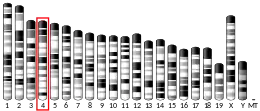| tyrosine kinase with immunoglobulin-like and EGF-like domains 1 | |||||||
|---|---|---|---|---|---|---|---|
| Identifiers | |||||||
| Symbol | TIE1 | ||||||
| Alt. symbols | TIE, JTK14 | ||||||
| NCBI gene | 7075 | ||||||
| HGNC | 11809 | ||||||
| OMIM | 600222 | ||||||
| RefSeq | NM_005424 | ||||||
| UniProt | P35590 | ||||||
| Other data | |||||||
| EC number | 2.7.1.112 | ||||||
| Locus | Chr. 1 p34-p33 | ||||||
| |||||||
Tyrosine kinase with immunoglobulin-like and EGF-like domains 1 also known as TIE1 is an angiopoietin receptor which in humans is encoded by the TIE1 gene.[5]
Function
TIE1 is a cell surface protein expressed exclusively in endothelial cells, however it has also been shown to be expressed in immature hematopoietic cells[6] and platelets.[7] TIE1 upregulates the cell adhesion molecules (CAMs) VCAM-1, E-selectin, and ICAM-1 through a p38-dependent mechanism. Attachment of monocyte derived immune cells to endothelial cells is also enhanced by TIE1 expression. TIE1 has a proinflammatory effect and may play a role in the endothelial inflammatory diseases such as atherosclerosis.[8]
See also
References
- 1 2 3 GRCh38: Ensembl release 89: ENSG00000066056 - Ensembl, May 2017
- 1 2 3 GRCm38: Ensembl release 89: ENSMUSG00000033191 - Ensembl, May 2017
- ↑ "Human PubMed Reference:". National Center for Biotechnology Information, U.S. National Library of Medicine.
- ↑ "Mouse PubMed Reference:". National Center for Biotechnology Information, U.S. National Library of Medicine.
- ↑ Partanen J, Armstrong E, Mäkelä TP, Korhonen J, Sandberg M, Renkonen R, Knuutila S, Huebner K, Alitalo K (April 1992). "A novel endothelial cell surface receptor tyrosine kinase with extracellular epidermal growth factor homology domains". Molecular and Cellular Biology. 12 (4): 1698–707. doi:10.1128/mcb.12.4.1698. PMC 369613. PMID 1312667.
- ↑ Rodewald HR, Sato TN (January 1996). "Tie1, a receptor tyrosine kinase essential for vascular endothelial cell integrity, is not critical for the development of hematopoietic cells". Oncogene. 12 (2): 397–404. PMID 8570217.
- ↑ Tsiamis AC, Hayes P, Box H, Goodall AH, Bell PR, Brindle NP (2000). "Characterization and regulation of the receptor tyrosine kinase Tie-1 in platelets". Journal of Vascular Research. 37 (6): 437–42. doi:10.1159/000054075. PMID 11146396. S2CID 43509019.
- ↑ Chan B, Yuan HT, Ananth Karumanchi S, Sukhatme VP (July 2008). "Receptor tyrosine kinase Tie-1 overexpression in endothelial cells upregulates adhesion molecules". Biochemical and Biophysical Research Communications. 371 (3): 475–9. doi:10.1016/j.bbrc.2008.04.091. PMID 18448073.
External links
- Receptor,+TIE-1 at the U.S. National Library of Medicine Medical Subject Headings (MeSH)
This article is issued from Wikipedia. The text is licensed under Creative Commons - Attribution - Sharealike. Additional terms may apply for the media files.



